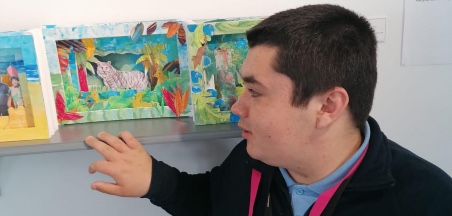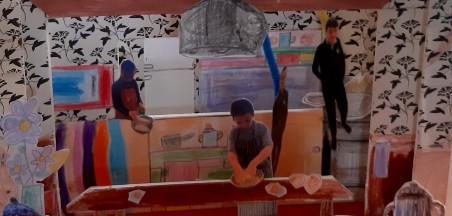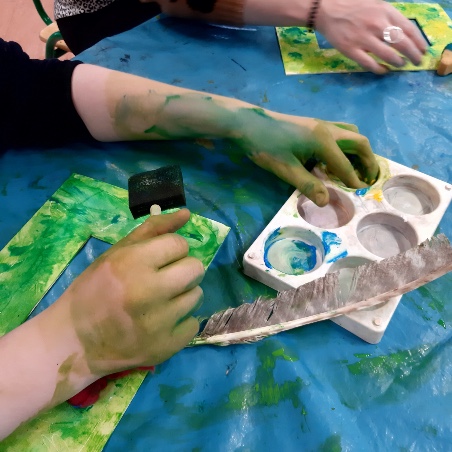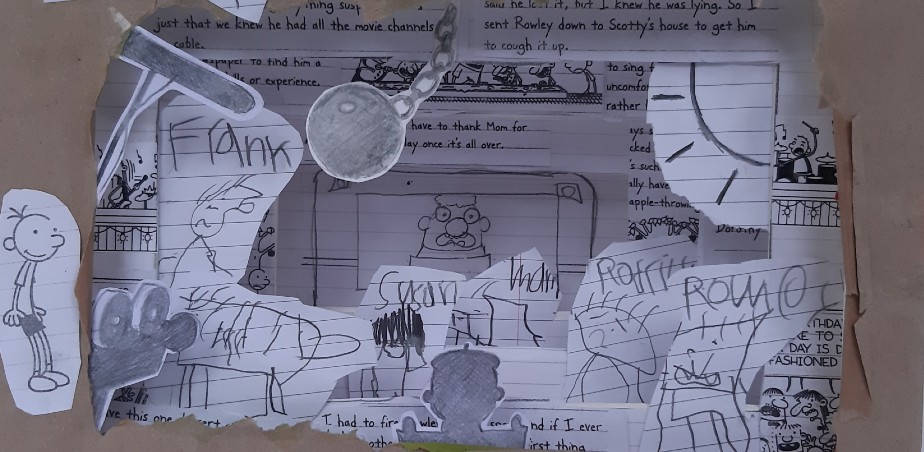Refine by Region
Refine by Art Form
Refine by School Level
The Inside Stories
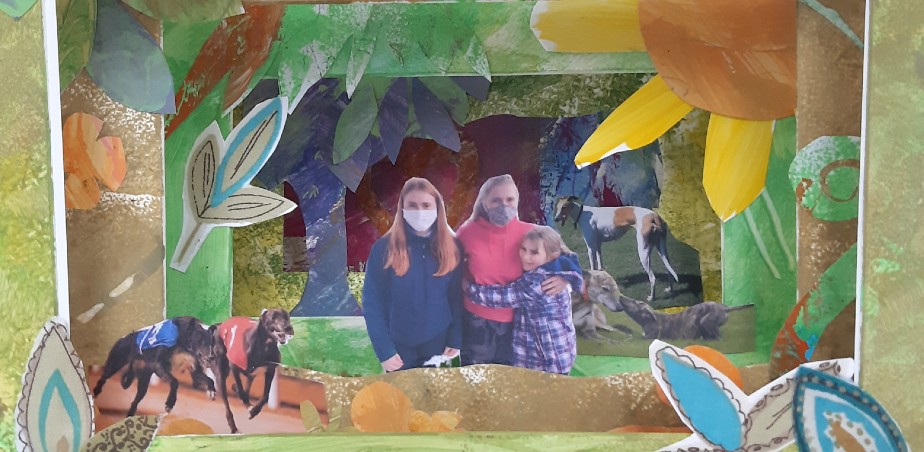
Tell us the story of your project – What was the impetus? What was it about? Who was involved? How did you begin?
This project was a visual arts residency with artist Shona McGillivray, teacher Michelle O’Halloran and the young people from the Sycamore, Poppy, and Buttercup classes, their class teachers, and support staff. The classes involved in this project are part of the specific ASD classes of the school and often the main challenge with children with ASD can be communication and expression of self. This project was an opportunity for the children to express their interests and individuality through art. Shona has built up a good relationship with the school’s community and has worked with Michelle and some of the children before thanks to the awards and support given for residencies by Clare Arts Office’s Embrace Programme and Artist in School.
We were all delighted to be able to have visitors again to the classrooms after the long restrictions and Shona started sessions in early January. The activities we were hoping to engage the young people with were open ended explorations of paint, print and collage. The resulting expressive pieces would then become the content of individual artist’s books. Participants were encouraged to express their own thematic interests, and we then provided them with relevant resources, ideas and material choices. Tunnel books are inspired by theatrical stage sets and Shona identified this format as a suitable backdrop to their creative stories. An end product that could also be handled, played with, and a visual prompt for further storytelling or written work within the classroom. Shona has been considering ways to engage audiences of visual art in a more tactile and meaningful way through the direct handling of the art. These physical books are designed to get close to, to peer into, just as you might gaze into the miniature staged life within a doll’s house, with curiosity and imagination. They create a 3-dimensional scene that tells a story.
How were the ideas developed and how did the young people, artist and teacher work together?
We began with a choice of different tactile tools, found objects, papers, paint and a heavy board surface to work on. This starting point became the back page of many of the books as well as acting as the getting to know each other stage. Shona could inquire about participants’ interests and this sparked some individual divergences of theme and approach for the following sessions. Those with verbal skills could communicate their own interests, and for some it was prompted by the teacher’s close knowledge of the young person. Honing into specific individual interests, sensory needs and creative strengths appealed to the participants emotions and led to a deeper engagement of the task in hand.
To assist with visualizing the end product a tunnel book template was made, and also the book’s blank pages or panels for each participant to work directly on to. Shona constantly responded to the children and their sensory seeking needs, often anticipating. One child became excited by the paint brushes alone and Shona responded by incorporating the tangibility of the fibers of the paint brush into the process. It was this meeting of their sensory needs in such a structured and meaningful way that made this experience so learner friendly and enjoyable. It was early in the school year and teaching and support staff were still getting to know the children so it was an insightful learning opportunity for those who were focusing on the children’s individualised learning targets. Each child has Individualised Educational Targets that are specific to their learning and overall progression. This creative process fulfilled many of the targets. One child who uses a communication device being motivated to choose colour, fabric, theme etc. meant that he had meaningful opportunities to communicate. For another child the targets are specific to him engaging in a meaningful way at a table top activity, our target was 3 minutes he often engaged for 15 minutes or more with Shona. Not only did the project incorporate oral language opportunities but it really incorporated very focused and targeted learning opportunities for the children.
It was important to the success of this project that everyone involved had an idea of the various stages of the project, so we could all work together in supporting the young people to be as actively engaged as they wished to be. The teachers gauge the young people’s moods, attention limits, when a break was needed, and used communication methods individuals would respond to. For Shona the teacher is the guide as to whether the creative road we are about to go down is positive or appropriate for that particular individual to take. We made suitably chaotic mess alongside the artwork and support staff were very efficient at restoring the environment back to its comfortable atmosphere for everyone in the class.
The finished art books were all different from one another, a few had front closing pages, some moving (hiding) parts, some have accompanying written stories and poems. They are all mini stages for tiny stick puppets, photographs of the participants that interacted and acted out their own stories within the different scenes. In each book you can take yourself down to eye level, peer in and enter its miniature layers, illusion of depth and story.
What was your personal experience of the project in terms of successes and challenges?
Shona MacGillivray, Artist
I know never to walk into an art space with too many preconceived ideas, but with a bag full of prompts and an open mind, however I still I get amazed at the creative crossroads that present themselves and the new processes I find myself gleefully jumping into! The Buttercup class was brilliant at this. One lad, who thinks so wonderfully outside of the box, took off on a very unexpected direction and I just had to, quickly, find a way to capture and share his ephemeral and spontaneous art. He took a literal interpretation of what was being asked, and was thoroughly enjoying the process in a way we hadn’t yet seen. I found myself responding creatively to his actions, and collaborating with him on what eventually became a series of 5 professionally printed images, mounted under Perspex with hand painted frames. This series for me represents enquiries into verbal and non- verbal communication and the pure enjoyment of painting.
Michelle O’Halloran, Teacher
Having worked in SEN for many years this was the first time I have worked specifically in an ASD setting with some older children. The age range in the class is 7 – 14 so catering for different levels of ability and making activities motivational and age appropriate can often be a challenge. Working with children who are challenged to express themselves in the “conventional sense” presents its own challenges, we are always seeking ways to engage with learners and share in their experience. The boys in Class Buttercup were so motivated and inspired by their project. The telling being the length of time spent engaged in the process itself. There are days when our class table top activities can present as a challenge but not when Shona arrived – the boys engaged in the sessions for the full length of time and not only were they engaged but extremely relaxed. Seeing the students initiate the lesson by getting what they needed for the project, for example baskets of animals when they saw Shona was really positive. It spoke volumes. It was amazing to see the associations and recognition of the project made as soon as Shona arrived. That was a success in itself.
To see the finished projects was so insightful too, each project was so individual and personal to each student and such a reflection of who they are. One of the greatest challenges of working with children who are deficient in the area of conventional communication is to enter their world, share their experience, understand their ways of thinking, the Inside Stories for me as a teacher became such an insight into each child it was amazing to get such a peek into each individual personality.
This project was so enjoyable from start to finish. Working with Shona is always really inspirational and she always informs my practice as a teacher. I just wish we had more opportunities to work together.
What was significant for you about the project that is worth sharing?
Shona MacGillivray, Artist
Coming into one of the classrooms on the fourth visit I saw one of the boys go into the side room and carry out the basket of toy farm animals, placing it on the table we were to work from. No one had asked him to do this, and his gesture was an unexpected acknowledgment of his understanding, his personal interest, excitement and his expectations for the activity to come. He was showing ownership of his project. I was delighted!
Each completed art book became more of a communication of a personal story than I had anticipated. In each book we get to see a little inside view of the young person’s passions, thoughts and humour. A view that can often go unseen.
Michelle O’Halloran, Teacher
For me it became about actually realizing the artist potential of one of my children, he never expressed interest in art up until this but I think that was because Shona recognized his creativity and that there was a process in what he was doing and she responded to this. I found that really inspirational so much so I challenged him in curricular learning and found he had more ability in other areas than I had first realized. He is now typing rather than writing and using ICT far more than I initially thought he could and this was down to seeing him engage in this project. He had only joined the class having been transferred from another and I didn’t really know him so to get to know him through this project was so insightful and such a positive experience for all of us. It also inspired my teaching and it was a different perspective as well so this for me was a massive learning experience.
Has anything changed in your work as a result of the project?
Shona MacGillivray, Artist
I am looking to develop directions of my own studio work into artist books. To create content that is more tangible and impactful through the format of a book and the handling and the “ reading “of it.
I would like there to be more physical connection to art through sensory and kinetic play. To look for book forms that will be opened by others led by their sense of curiosity, that they will puzzle over them, and find joy in discovering its hidden contents.
Michelle O’Halloran, Teacher
I am now more about the process than the product – as teachers we can often become focused on the outcome and having a uniformity when it comes to art. But this project presented the doing as being such a sensory and enjoyable experience for the children that I really saw the stripped back benefits of the process.
Also seeing Shona allowing the child to lead and going with them rather than directing them that has inspired my own teaching this year, it’s her artistic response. As I mentioned working with children that are challenged in a communicative sense we are trying to share their experience but following the child’s lead is an invitation to enter their world.
“It was really awesome… I got to use my favourite book Diary of a Wimpy kid.”
– Shane“It was so cool… Olaf is my favourite… It was amazing, so fun.”
– Issac“I love cooking… I loved the tunnel book.”
– Maeve
Spotlight
Artist(s):
Shona MacGillivray, Artist
I am a visual artist with over 20 years’ experience of working in arts in education, community arts and from my own studio. Originally from the Highlands of Scotland and a graduate of drawing and painting from the Glasgow School of Art. My studio practice explores our human connection with our natural surroundings. I am concerned about bio diversity and climate change and the human connection to this crisis. I paint and draw in acrylics, inks, spray paint and charcoal on canvas, paper, walls and windows.
In 2007 I established The Art Box, a school of art offering regular sessions to young people. This was an opportunity to collaborate with and be informed by children in an informal setting. I have a long-term interest in the inclusive practices of learning through creativity as, like many families mine is complemented by having both neurodivergent and neurotypical members.
I have been awarded many arts in education residencies through the Artist in School and the Embrace Arts and Disabilities programmes, Clare Art Office. I am a selected artist for BLAST in Galway and Clare, as well as the lead artist for the Teacher-Artist partnership CPD course in Galway Education Centre. The collaborative school project “Welcome to our World” with St. Anne’s special school, CBS and the Embrace Programme was presented at the Arts in Education National conference 2019. In 2021 I was selected for the special initiative training TAP Programme, partnered with Kids' Own Publishing Partnership.
Teacher(s):
Michelle O'Halloran, Teacher
I am a primary school teacher qualifying in Mary Immaculate College in 2002. I am currently a class teacher in St. Anne’s Special School, Ennis, Co. Clare. Prior to joining the staff at St.Anne’s, I taught in an Educate Together school for over 10 years. I also spent a few years teaching in an Elementary school in the Bronx, New York and a primary school in Brighton, England.
Having gravitated over the years to teaching specifically in an SEN setting, I have been fortunate enough to be involved in a lot of collaborative art projects. Back in 2018, Shona and I worked together with another primary school on an inclusive art project called Welcome to My World. We presented at the Arts in Education Portal in Galway alongside the pupils involved.
For two years I worked with a Creative Cluster, three schools were involved in this project called Cairdre an Dúlra. Prior to this I had another opportunity to work with Shona on another Embrace project.

Artist(s)
Shona MacGillivray

Teacher(s)
Michelle O’Halloran
Deirdre Flynn
Edel McGuane
Artforms
School Level
School/
Participant Group
St. Anne’s School, Ennis, Co. Clare
No. Participants
14
Region
Age/Class
7 - 15
Dates
January & February 2022
Weblinks
Leading Agency
Clare County Council Arts Service
Key themes/ lines of enquiry
To create a space for young people with ASD who require supported needs to willingly express themselves creatively.
To foster a sense of curiosity, intrigue and fun whilst engaging with a variety of materials and methods.
To present their creativity in such a way that will both celebrate and communicate their interests to others
To make visits to art exhibitions more hands and accessible experiences for everyone.
Curriculum Strands
Strand: Paint and colour
Strand Unit: Painting/ Looking and responding
Strand: Print
Strand Unit: Making Prints/ Looking and responding
Strand: Construction
Strand Unit: Making Constructions/ Looking and responding
Strand: Drawing
Strand Unit: Making drawings/ Looking and responding
Strand: Oral Language
Element: Engagement, Listening and Understanding Motivation and Choice, Social Conventions and Awareness of others
One of the greatest challenges of working with children who are deficient in the area of conventional communication is to enter their world, share their experience, understand their ways of thinking, The Inside Stories for me as a teacher became such an insight into each child it was amazing to get such a peek into each individual personality.
Michelle O'Halloran, Teacher
